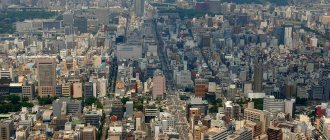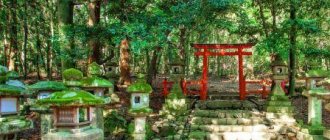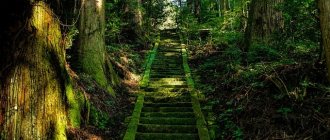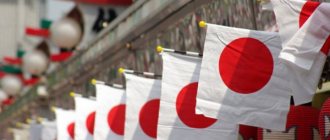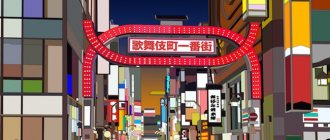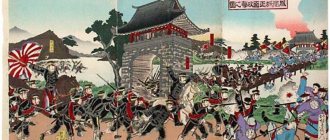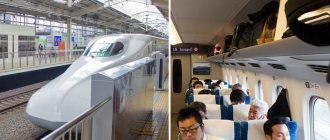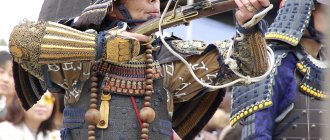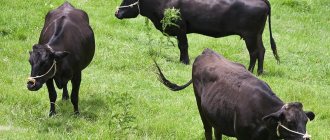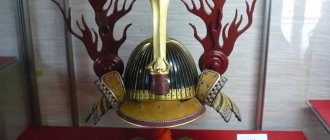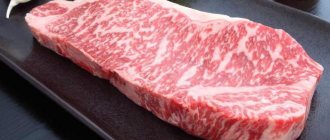Kobe from A to Z: map, hotels, attractions, restaurants, entertainment. Shopping, shops. Photos, videos and reviews about Kobe.
- Last minute tours
around the world
Kobe is the sixth largest city in Japan and the capital of Hyogo Prefecture. The largest port city in Japan (and one of the largest in the world) with a population of about one and a half million people. Throughout its history, it was a center of international trade; it was in this city that Europeans first began to settle in Japan.
Now there are very few old buildings left in Kobe, because in 1995 there was an earthquake, from which the entire city suffered greatly, and it was almost completely rebuilt over the next 10 years. Kobe is currently considered the best place to live in Japan.
How to get to Kobe
By plane
Only domestic flights arrive at Kobe Airport. Japan Airlines (JAL) and All Nippon Airways (ANA) operate from Tokyo, Sapporo, Okinawa and Kagoshima, while ANA operates from Niigata and JAL operates from Kumamoto. Cheap flights from Tokyo and Naha are available from Skymark.
A high-speed train leaves the airport every 10 minutes and takes you to Sannomiya Station in less than 20 minutes, where you can change trains or take the subway.
The nearest international airport is Kansai International Airport. You can get from here to Kobe by bus, a little more than an hour from Sannomiya Station, or by Kaijo Access high-speed ferry, which departs every 45 minutes and takes about half an hour.
Find cheap flights to Kobe
By train
High-speed trains depart from Tokyo and go to Shin-Kobe Station. The Nozomi train takes 2 hours 50 minutes, the Hikari train takes a little longer - 3 hours 20 minutes.
Several trains depart from Osaka to Kobe and arrive at Sannomiya Station. The Tokkyu bullet train takes about half an hour, while the Kaisoku Kyuko train, departing every 20 minutes from Namba Station, takes you to Kobe in 45 minutes.
From Kyoto the train journey takes 50 minutes.
By bus
If you're traveling to Kobe from Tokyo, you can save on travel costs by taking a JR Bus Group bus.
Daytime buses only go to Osaka, but from there you can quickly get to Kobe. These buses spend about 8.5 hours on the road. There are also several night buses from Tokyo to Sannomiya.
On a ferryboat
Several ferries arrive daily in Kobe - from Takamatsu (3.5 hours), Katakyushu (12 hours), Oita (12 hours), Beppu (12 hours) and Okinawa (3 days). In addition, there are two ferries departing from China - from Shanghai (45 hours) and Tianjin (50 hours).
Nankinmachi
Nankinmachi is one of the three main Chinatowns in Japan, along with those in Yokohama and Nagasaki.
About 100 Chinese companies operate here. The main street is an intersection with Seian-mon gates to the west, Choan-mon to the east, and Kaiei-mon to the south. The northern part connects to Motomachi shopping street.
Most of the shops in Nanjingmachi are restaurants and cafes serving light food. Some stores sell dim sum, snacks, steamed meat buns, etc. So, you can try many different treats.
Transport
Kobe has two subway lines, the Kaigan line along the coast, and the Yamate-Seishin line, which takes trains towards the mountains. A one-day ticket for both lines costs 1000 JPY, and for 1100 JPY you can also ride the bus.
Prices on the page are for November 2021.
By bus you can get to almost anywhere in Kobe. For detailed information on all local bus schedules, please contact the tourist office located near Sannomiya.
The city also has tourist buses that follow a circular route past many scenic spots and attractions. These buses leave every 15-20 minutes and cost 260 JPY, or 660 JPY if you buy an all-day ticket.
Kitano-Tenman-jinja Shrine
The Kitano Tenman-jinja Shrine is located in Kobe City, Hyogo Prefecture, where Sugawara no Michizane, the deity of teaching, is enshrined. In 1880, when Emperor Taira no Kiyomori moved the capital of Japan from Kyoto to Kobe, the Kitano-Tenmangu-jinza Shrine was also moved to Kobe to serve as the guardian of the new capital (such shrines usually protect the domain of the Emperor and protect the disadvantaged quarter of the capital from evil spirits).
The Honden (main hall) was built 260 years ago. The honden, sukibei (openwork wall), haiden (prayer hall), torii (Shinto shrine passage), toro (garden lantern) and isidan (stone staircase) are officially recognized as cultural heritage of traditional architecture.
The temple hosts many festivals dedicated to the main deity. Festivals include both traditional Shinto and international performing arts festivals, in keeping with the spirit of a cosmopolitan city like Kobe.
Kobe Hotels
There are tons of places you can stay in Kobe, from budget hostels to luxury waterfront hotels. If you cannot find an available hotel, you can contact the travel office at Sannomiya Station. They can also help you find the most budget option.
Kobe Harborland New Otani is part of the large Japanese chain New Otani and can offer you excellent service for JPY 25,100 per night.
Tor Road Hotel is conveniently located in the heart of Kobe's shopping district, close to many restaurants and shops. A night in a single room will cost you 19750-23100 JPY.
If you don't want to spend a lot on accommodation, we can recommend you Kobe Kur Haus, with its own spa and prices, Ninomiya Ryokan or Kobe Dears Backpacker House, a small cozy hostel that has a dormitory.
Kobe is famous around the world for its marbled beef, but if you decide to try it, be prepared to pay at least 15,000 JPY per serving.
Kobe City Museum
The Kobe City Museum is a humanities museum located in Kyo-machi, Kobe. The main theme of the museum is “international cultural exchange - contact between Eastern and Western cultures and their changes through interaction.” The museum has about 50 thousand exhibits from the collection, ranging from archaeological materials from ancient times and the Middle Ages to the period of isolation and Westernization of Japan. Famous works from Japan are on display, including statues of Saint Francis Xavier, Oda Nobunaga, Toyotomi Hideyoshi, as well as Kanayama Heizo and Koiso Ryohei. The museum building was the latest creation of the architect Sakurai Kotaro and is registered as an important national cultural property.
Kobe Restaurants
Gaen Shuga serves some of the best Cantonese and Hong Kong cuisine in the city, and you can also request that some delicacies be prepared especially for you, such as shark fin soup or abalone.
There is a discount coupon on the restaurant's website that you can print out.
Sky Buffet may be difficult to find, but the view from this restaurant's 24th floor window is well worth the time it takes to find the building. In addition, the prices there are quite affordable, and, in addition to excellent Japanese cuisine, they can also offer you more familiar European dishes.
Grill Ippei restaurants serve excellent ebi furai and kaki furai (battered shrimp or oysters fried in boiling oil), steaks and tonkatsu (pork cutlets). And if you just want to have an inexpensive lunch, go to any cafe in Chinatown, located next to Sannomiya.
Kobe
In the southwestern part of the island of Honshu in Japan is the large city of Kobe. It is one of the largest seaports in the whole world. Located in Hyogo Prefecture, it has long been a center of Japanese trade. On the way to the ancient Japanese capital of Kyoto, the city of Kobe was a religious Shinto center with three shrines (Minatogawa, Nagata, Ikuta). The emblem of the city of Kobe is a photo of two fans crossed in the shape of a sign depicting the Japanese letter "K". The population of one of the largest cities in Japan, Kobe, reaches 1.5 million people.
Climate Kobe Japan
The weather in Kobe, Japan is moderately warm with high rainfall. It is best to come here in spring or autumn. In April-May, rain is rare, and the air temperature ranges from +18°C to +25°C. The summer months are rainy and windy. In autumn, until November, it is warm and comfortable here. Warm currents mean that you can swim in the sea starting in May. In July-August, the sea water temperature reaches +24°C.
Sights of Kobe
The city of Kobe suffered greatly from the severe earthquake that occurred here in 1995. Over the next 10 years, it was practically rebuilt. Today it is one of the best places to live in Japan. There are many attractions to see when visiting Kobe:
- Ijinkan
are residences of foreign diplomats and wealthy merchants, built in the 19th century. Located near Shin-Kobe and Sannomiya stations. Several of the same ancient buildings are located near Motomachi Station. - Meriken Park
- here is a monument to those killed in the earthquake, as well as the Kobe Tower, which is a symbol of the city. The park has many flowers and greenery. In spring, approximately 10 thousand tulips bloom here. You can admire this delightful spectacle every day from 10-00 to 18-00. - There is another large park in the city, Takenaka
. This beautiful garden has more than 200 species of different herbs. There is a cable car and a restaurant. The park often hosts various exhibitions. - At the Hakutsuru Museum
you can learn about the production process of sake rice vodka and taste the popular drink for free. The museum is open daily, except Mondays, from 19-30 to 16-30. - Himeji Castle
is a classic example of Japanese architecture. The outside is an elegant building, but inside it is a well-fortified defensive structure with gloomy interiors. - The Akashi-Kaikyo Bridge
is the highest and longest in the world. He is twice listed in the Guinness Book of Records. This hanging structure connects Kobe with the city of Awaji, located on the island of the same name.
Hotels and restaurants Kobe
There are plenty of places to stay in this port city. These include inexpensive hostels and luxury hotels on the embankment:
- Kobe Meriken Park Oriental Hotel is located near Meriken Park. The rooms have a pleasant interior and have all the necessary amenities and free internet access. The windows offer beautiful views of the park and the sea harbour.
- Kobe Portopia – The hotel is located next to the metro station. Guests can use one of 13 restaurants, bars and cafes and sample European or Japanese dishes. Tourists have tennis courts, a fitness center, and an indoor swimming pool at their disposal.
- Miyukisou Hanamusubi is a ryokan with hot spring baths. It is located next to the Arima-onsen train station. Decorated in traditional Japanese style, the hotel provides rooms with futon mattresses and tatami mats. Here you can visit the public baths or, for a fee, use a private bath with a massage session.
The following establishments break records for attendance and are famous for their excellent service:
- Gaen Shuga Restaurant serves Hong Kong and Cantonese cuisine. Here you can taste delicacies such as abalone or shark fin soup.
- Sky Buffet is located on the 24th floor of a high-rise building. Its windows offer a wonderful panorama of the city. The restaurant serves dishes of Japanese and European cuisine at very affordable prices.
- The Grill Ippei restaurant chain offers visitors battered oysters and shrimp, steaks and pork cutlets. You can have an inexpensive lunch at any cafe in Chinatown.
Shopping in Kobe, Japan
Japanese products are known all over the world for their excellent quality. Therefore, any tourist who comes to the country must go shopping. A visit to Kobe is no exception in this sense. There are many shops here, the goods in which will satisfy the most capricious customers:
- The Mattotti store, located at Demain 1F 1-7-11650-0003, sells women's clothing.
- Bags and other leather goods can be purchased at Genten, located at Sannomiya-Chochu-ku 650-0021.
- Space by Edition, located at Sannomiya-cho 3-6-1, offers a large selection of women's and men's clothing and shoes, as well as various accessories and jewelry.
- You will find many fashion trends in clothes, shoes, bags at the NANO UNIVERSE store, which is located in Kobe, Hyogo Nishimachi 330650-0038.
How to get to Kobe, Japan?
Kobe Airport (Japan) accepts domestic flights only. There is a high-speed train from the terminal, which can take you to any desired direction in the city. International airlines fly to Kansai Airport. From there, buses and high-speed ferries run to Kobe.
From Tokyo you can get to Kobe by train. Travel time is from 2 to 3 hours. From Osaka the journey will take about half an hour, and from Kyoto – up to 50 minutes. It will be cheaper to travel to Kobe by taking a JR Bus Group bus.
Another option for getting to the city is by sea. Ferries from Takamatsu, Kitakyushu, Oita, and Okinawa arrive at the port of Kobe every day. You can also get here by sea from Shanghai and Tianjin in China.
Entertainment and attractions in Kobe
Ijinkan - built in the 19th century. residences of foreign merchants, the main attraction of Kobe. Located within walking distance from Sannomiya or Shin-Kobe Station. In addition, several buildings from the 19th century. There is one in the Kyu-kyoryuchi area, next to Motomachi Station.
Meriken Park houses a monument to earthquake victims and the Kobe Tower, an unofficial symbol of the city. The Flower and Fruit Park is surrounded by a huge amount of flowers and greenery. In spring, when about ten thousand tulips bloom in the park, it becomes the most beautiful. Entrance is open from 10 am to 6 pm.
The Takenaka Carpentry Tool Museum displays a variety of carpentry tools, ranging from ancient stone axes to various modern tools. Nunobiki Park is a 40-acre garden featuring over 200 varieties of herbs. There is also a restaurant in the garden and exhibitions are often held. With your entrance ticket you can ride there and back on the cable car.
Kobe is famous for its breweries and sake distilleries. Many of them are open to visitors, and you can find a map of their locations at the tourist office.
Kobe is famous for its breweries and sake distilleries. Many of them are open to visitors, and you can find a map of their locations at the tourist office. The sake production process is presented in more detail at the Hakutsuru Museum, open daily except Mondays from 9:30 to 16:30 pm. Admission is free, sake too.
Oji Zoo is open daily from 9:00 to 16:30 from March to October and from 9:00 to 16:00 at other times. In addition to animals, the zoo has attractions for children. In addition, we recommend that you visit the Arima Onsen hot springs, famous throughout Japan.
History of Kobe
Located on Honshu, Kobe-shi is an industrial, commercial, port center. Now it accounts for a third of Japan's total foreign trade, a third of the ships built in Japanese shipyards. In the past, Kobe was part of the Izumi region, located on the trade route leading to the capital Kyoto. In that era, Kobe was a city of moneylenders, merchants, sake producers, and Shinto sects. Since the mid-19th century, it has become the center of the country's renewal and industrial modernization. Workshops for the production of artificial pearls are opened here. The name of the city is reminiscent of the fate of the famous athlete Kobe Bryant - he also found himself at the epicenter of the disaster, like the famous basketball player. The fate of the settlement turned out differently - for people, the disaster became the final point, but the Japanese city quickly recovered and increased its potential.
Historians, determining when the city was founded, have established that people inhabited the region in the Jomon era - 12 thousand years before the beginning of the current era. This is confirmed by stone tools. Since the area is rich in fish and has a good climate, a port was soon built here. Kobe is mentioned in the oldest Japanese literary work - Nihon seki. During the Nara era, Heyan the settlement was called Owada-no-tomari (Owada anchorage). Diplomatic embassies sailed from here to China.
Port city
The year 1180 is special in the history of Kobe. It became the Japanese capital when the emperor moved to Fukuhara. Formerly an independent settlement, Fukuhara is now part of Kobe. Four years later, the fortress and sanctuary of the city found themselves at the epicenter of the battle of Ichi-no-Tani. A year later, the Kamakura era began, lasting until 1333. Kobe had good opportunities, so the region began to actively grow. In the 13th century, the settlement was called Port Hyogo. He belonged to Settsu Prefecture. In 1868, foreign merchant ships began to be received here - the port was among the pioneers in trade with Western powers after centuries of closed politics.
Modern Kobe (sometimes incorrectly called Kobe) was founded in 1889. The name is derived from an ancient term that denoted the servants of the local ancient sanctuary. Since the first autumn day of 1956, the settlement has been one of the cities of national importance.
One of the largest ports in the world
On March 17, 1945, the port was hit by bombs dropped from American military aircraft. The attack caused 21% of buildings to collapse; the official number of victims is 8,841 people. Since the spring of 1975, ships with nuclear weapons have been prohibited from entering the port. The condition was called Kobe's formula.
In 1995, the Japanese city became the victim of a major earthquake. The disaster with a magnitude of 7.3 led to widespread destruction (including bridges, roads); the estimated number of victims is 5,000 citizens. After the disaster, the settlement was rebuilt almost from scratch. Now Kobe is the 4th largest Japanese port and the 38th largest port in the world.
Arima Onsen
Arima Onsen Hot Springs are one of the oldest springs in Japan, located in the Kita region. The history of Arima Onsen goes back so many years that even the historical document Nihon-Soki, which was written during the Nara period (710-794 AD), contains a line about it. It states that Emperor Jōmei stayed there for three months in 631. Other famous people from this period included Sei-Sonagon, who wrote about Arima Onsen in his story Makura no Sauces. It is also known that Hideyoshi Toyotomi visited here in 1596. When the building was destroyed by the Keicho-Fushimi earthquake, Hideyoshi donated a lot to restore it. Hot springs are Kobe's main natural attraction.
Rokko Cable Car
The Rocco Cable Car runs 1.7 km between Shita Station, located at the foot of Mount Rocco, and Rocco Sanjo Station. The difference in height between them is 493.3 meters. The journey takes about 10 minutes. But people come here not just to use transport, but to enjoy the beauty that opens up. The Art Deco building of Rokko Sanjo Station, opened in 1932, has remained unchanged since its opening. And it is still carefully preserved.
Tenran-dai, an observation deck located right next to Rokko Sanjo Station, offers stunning views of the city.
Guide: Yokohama Attractions
Source
Best cafes and restaurants
There are so many coffee shops in Kobe, so you have a lot of choice when it comes to needing to boost your caffeine levels or find a quiet place to relax or study.
Downtown is the place to go if you're looking for chain coffee shops like San Marco, Doutor, and Starbucks. These are good places to study, since most often in such cafes you can use free wi-fi and spend as much time there as you like.
Streamer coffee - Although this is also a chain coffee shop, it is still very good. This is a completely new place with a bright and airy atmosphere. The cafe is located in a quiet and beautiful area of the port, where you can charge your phone and use Wi-Fi. Plus, if you need or just like dairy-free alternatives to regular drinks, they have a range of offerings that many other places don't have.
When it comes to restaurants, it's a little difficult to make specific recommendations. Of course, Kobe is famous for its one and only Kobe Beef , which is renowned throughout the world for its tenderness and marbling of the meat. As you would expect, the city enjoys this global popularity and there is plenty to choose from.
What may surprise you is that there are many ramen restaurants in Kobe that are definitely much cheaper than places that serve Kobe beef. Once again, you have a wide variety of ramen shops to choose from that are worth eating at.
KOBE
Ikuta Shrine. Founded in the beginning 3rd century
KOBE, city in Japan, adm. center of Hyogo Prefecture. Us. 1532.3 thousand people (2008). Located in the southwest of the island. Honshu, on the coastline. Osaka Inland Sea. Means. part of the mountains The territory consists of the bulk islands of Port Island (1966–81, 826 hectares, connected to the city by a double-tier bridge and the Minatojima underwater tunnel) and Rokko (1992, 595 hectares). One of the most important transport hubs in the country: the Meishin, Hanshin, Sanyo, Chugoku, Kobe-Awaji-Naruto expressways intersect in K. Road bridge across the strait. Akashi (1998; length over 3.9 km; height of supports 298 m - the highest and longest suspension bridge in the world) is associated with the island. Awaji. Final entry railway station Tokaido highway (Kobe - Tokyo). Along the northern outskirts of K. in the tunnel there is a high-speed railway line "Tokaido-Sanyo" (Tokyo - Fukuoka). Shinkansen village (Shin-Kobe station). Airport (on an artificial island connected by a bridge to Port Island; 2.7 million passengers in 2006). Large port. Freight turnover is 95.5 million tons (of which 48.7 million tons are foreign trade cargo, 46.8 million tons are coastal shipping; 2006). In 2006, 26.8 million tons of foreign trade goods were imported (including 13.1% coal, 7.4% textiles, 6.2% fruits and vegetables), 21.9 million tons were shipped (including 22.6% machine tools, 11.6% cars). Ferry connections to the ports of Takamatsu and Matsuyama (Shikoku Island), Kitakyushu and Oita (Kyushu Island). On Dec. 2007 ports of K., Amagasaki-Nishinomiya-Asia, Osaka and Sakai-Semboku in the hall. Osaka is administratively united into the port of Hanshin. There are two subway systems in Kobe (Kobe Rapid Railway, 1968, and Kobe Municipal Subway, 1977). An extensive network of mountains. railways, including two fully automated. lines: “Port Island” (opened in 1981 - the world’s first automated public transport system) and “Rocco” (1990).
Settlement on the site of modern K. has been known since ancient times. During the Heian Mor period. port, in the Tokugawa era the only Japanese one. port open to trade with Europe. merchants. After 1868 Japanese The authorities allowed foreigners to settle in the city. missionaries and traders who were allocated plots of land here. The Kobe–Osaka railway was built in 1874. City status since 1889. During the Sino-Japanese War of 1894–95 and the Russian-Japanese War of 1904–05, K. was a Japanese base. Navy. Beginning in 1907, the port of K. was significantly expanded and became one of the largest in Japan. In subsequent years, the city also developed as a shipbuilding center. It was heavily damaged by bombing during World War II (the port resumed its full operations only in the second half of the 1950s). In Jan. 1995 K. was destroyed by an earthquake, by 2005 it was actually rebuilt.
The city stretches along the sea. coast, has an irregular layout. To the center. parts of K. are dominated by European buildings. type con. 19 – beginning 20th centuries On the territory of K. there is the largest mound-kofun Goshikizuka in Hyogo Prefecture (late 4th - early 5th centuries), temple complexes, including the Shinto shrine Ikuta (founded in the early 3rd century), the oldest rural estate in Japan Hakogi-Sennenya (15th century). Among the buildings of the 20th century. – neo-Renaissance building of the Hyogo Prefectural Government (1902, architect Hanroku Yamaguchi), high hyperboloid structure. 108 m "Kobe Port Tower" (1963).
K. is a major center of education and science in Japan. As part of the Port Island Development Project, a medical center was created in the city (1996). industry (including the Institute of Biomedical Research and Innovation, the Center for Translational Research and Development in Informatics, etc.). Among other scientific. institutions: Institute of K. - branch of the Institute of RIKEN (the only comprehensive institute of natural sciences in Japan), National. Institute of Earth Sciences and Disaster Prevention, Asian. earthquake risk reduction center. State universities: University of Foreign Countries Studies (1946, current name and status since 1949), Kobe University (1949). Among the non-state universities are Konan University, Konan Women's University, Gakuin University, International, Design, Pharmaceutical, Health, Hyogo Prefecture. Municipal library, libraries of the university. Museums: fine arts Hakutsuru (1931), Kosetsu (1972, Japanese and Korean painting, sculpture, ceramics), city (1982), Daimaru (1983, modern art), arts of Hyogo Prefecture (1997–2001, arch . Tadao Ando), marine, historical, music and muses. instruments, fashion, dolls, glass lamps, wine, etc. In 1985, the Universiade was held in Kazan, and in 2002, matches of the World Football Championship were held.
K. is an important industrial center; with the cities of Osaka and Kyoto it forms the industrial core. Keihanshin zones. Prom. businesses are concentrated in the center. and southwest areas of the city. Representative offices of more than 100 international companies are located in Kazakhstan. corporations (“Procter & Gamble”, “Nestlé”, “Eli Lilly and Company”, “Toys “R” Us”, etc.), headquarters and enterprises of the largest Japanese. companies, including one of the two headquarters of the Kawasaki Heavy Industries corporation and those that are among its leading enterprises: Kobe Works (production of steam and gas turbines, diesel engines, compressors, etc.) and Hyogo Works" (locomotives, carriages, etc.). Shipbuilding. plant of the Kawasaki Shipbuilding Corporation (high-speed passenger ships and ferries, submarines, bathyscaphes, etc.). Metallurgy enterprises (in Kazakhstan there is a steel mill and one of the two headquarters of the Kobe Steel corporation), precision engineering (Kawasaki Precision Machinery). Chemical technologies have also been developed. and petrochemical, textile, shoe (including sports shoes - ASICS) industry. Production of confectionery products (companies: “Konigs-Krone”, “Glicopia”; “Morozoff” - founded in 1931 by Russian entrepreneur V.F. Morozov), sake (factories “Sawanotsuru” and “Hakutsuru” - one of the oldest and most famous in Japan); a large plant of the Kirin brewing company (controls 50% of the domestic beer market in Japan).
Within the city, to the north. on the slopes of the Rokko mountain range (altitude 932 m; part of the Setonikai National Park), – Arima hot springs (used for medicinal purposes since the 8th century).
15 km west of K. - Akasi city, sea. resort and mechanical engineering center (production of motorcycles, all-terrain vehicles, industrial robots, gas turbines, etc.; Akashi Works plant of Kawasaki Heavy Industries corporation).
In the area of K. on special. traditional This method is used to raise cows of the local Tajima-Ushi breed (their meat has a special taste).
Kobe Port Tower
The 108-meter-high steel tower dominates the port city as a striking dominant feature.
Construction of the Kobe tower was completed in 1963. The observation deck is located at an altitude of 98 meters and is open to tourists from 9 am to 8 pm. From the top of the red steel structure there is a picturesque view of the surrounding area. The massive structure looks especially bright at night in the light of numerous lanterns and spotlights.
In its mesh structure, the tower is similar to the famous towers of engineer V.G. Shukhov; its hyperboloid structure gives it special strength and stability. It was this quality that allowed the Kobe port tower to withstand the devastating earthquake of 1995.
Coordinates: 34.68375800,135.18608100
Tasaki Pearl Plaza
Tasaki Pearl Plaza is a place where jewelers' works, mainly made of pearls, are exhibited. It is located in the central office of the jewelry company TASAKI & Co., Ltd. in Kobe. Tasaki is a jeweler who co-created the crown for Miss Universe Japan. You will be able to see a variety of objects made of pearls by the jeweler Tasaki himself: “Pearl Bridge” is a miniature of the Akashi Kaikyo Bridge made of pearls, “Aphrodite’s Crown” is a crown made of precious metals and stones with pearls, “Pearl Doll Kobe Likka-chan "- a doll decorated with pearls worth ten million yen, "Shinju-no-Onagadori" - a rooster with a long tail made of pearls and precious metals, and so on.
